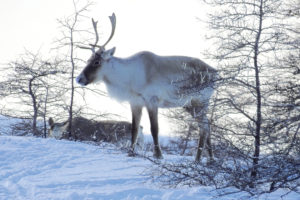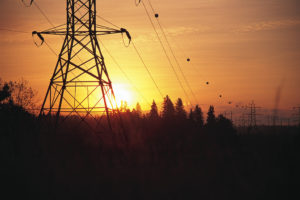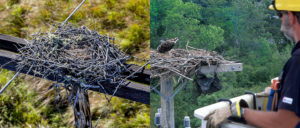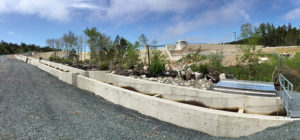Protecting Biodiversity
Emera’s environmental commitment drives our focus on protection, preservation, recovery and education. Throughout our operating regions in 2016, less than 0.07 per cent of our electrical transmission area and less than 0.06 per cent of our gas distribution area overlapped with land designated as having high biodiversity value. Our operations encountered 23 species that are listed as protected, vulnerable, or endangered by various agencies in 2016. All of our companies follow applicable rules and regulations when we encounter these species.

Protecting manatees and marine habitat
Tampa Electric’s Manatee Viewing Center near the Big Bend Power Station celebrated 30 years and 5 million visitors in the 2016-2017 seasons. Manatees flock to the warm waters of Big Bend’s discharge canal, now a state and federally designated manatee sanctuary that provides critical protection from the cold for these unique, gentle animals. The center also features an educational building, gardens, a 900-foot tidal walk and a habitat trail loop with a 50-foot observation tower.
In 2016, the Tampa Electric team completed Newman Branch Phase III Restoration Area in Apollo Beach, Florida. Under this program, 100 acres has been restored including the removal of invasive plants, creation of upland and wetland coastal ecosystems, and reconnecting Newman Branch Creek to upstream waters. The work was completed in partnership with the Gulf of Mexico Foundation, Tampa Bay Estuary Program and the Southwest Florida Water Management District. The site is used for outdoor education and research.
Protecting habitats and species in New Mexico

New Mexico Gas Company supports federal laws, such as the U.S. Endangered Species Act, by reviewing our impacts on critical habitat and threatened and endangered species. For example, threatened cacti have been transplanted from construction areas on numerous projects. We also conduct biological surveys before major projects and protect active bird nests until the young have fledged. Our environmental specialists also ensure that sediments from projects are reduced to comply with the U.S. Clean Water Act, which limits runoff from washing into waterways. We currently have about 10 projects being monitored for erosion control. Finally, when bees were found inside our Business Center in Albuquerque last April, management brought in a bee specialist to relocate the bees instead of eradicating them.
Maritime Link environmental benefits

The Maritime Link transmission project will not only deliver cleaner hydroelectricity to customers in Nova Scotia and beyond – it has also been constructed in a way that’s respectful of the environment and minimizes impacts. In 2013, the Emera Newfoundland and Labrador team received Environmental Assessment (EA) approval from the Canadian Environmental Assessment Agency, Nova Scotia's Department of Environment, and Newfoundland and Labrador's Department of Environment and Conservation. This approval was the result of a comprehensive study and submission from the project team, which became the blueprint for ensuring environmentally responsible construction.
The EA submission included commitments to reduce the environmental impact of the project by taking advantage of areas already set aside for existing transmission and infrastructure. This reduces the amount of disturbance to animal habitat and increases the land available for predation and hunting.
In addition to minimizing environmental impacts, the Maritime Link project has also been working to enrich wildlife habitat. We provided 10.78 hectares of wetland compensation for the Maritime Link project in 2016, developed in agreement with Ducks Unlimited Canada. We also worked with contractors to create four new nearshore rock reefs at Big Lorraine in Cape Breton. These reefs, made from different-sized rocks, will add value to the food chain by allowing a variety of species to grow and support marine life.
Additionally, Emera Newfoundland and Labrador is conducting baseline studies and ongoing monitoring programs of species such as snow crab, lobster, caribou and American pine marten. Through these studies, we are able to collect scientific data that can be used to help assess the overall health of various species and effectiveness of migration measures initiated by our company.
Managing Vegetation Responsibly

In Florida, Nova Scotia and Maine, we’re managing our transmission corridors so they can provide habitat and food for local wildlife.
Our electrical companies use environmentally sensitive vegetation management programs to help maintain the reliability of our transmission and distribution lines. In Nova Scotia and Maine, for example, we work to nurture compatible shrubs and trees near our powerlines that will provide habitat and food for wildlife, while also helping to control the growth of tree species that can interfere with power delivery. This work includes fostering species that are important to natural pollinators, recognizing the important role these insects play in our ecosystems. And in bird nesting season, crews look for nests, chicks and eggs and create buffer zones where nesting sites are found. In addition, we provide information and resources to help our customers understand the best kinds of plants to foster around power lines.

We also recognize that many of our power lines share territory with bird species, and we have processes in place to make certain that habitat and nesting sites for critical bird species are maintained near our assets. Tampa Electric has an avian protection program to safeguard ospreys. Nova Scotia Power and Emera Maine also have osprey relocation programs and procedures.
Working with Wildlife

Nova Scotia Power invested $4 million into building the largest fish ladder in the province at Sandy Lake Dam, helping in recovery of the Gaspereau fish who have returned to spawn in the Indian River for the first time in well over 100 years.
The team at Nova Scotia Power is actively involved in the conservation efforts and recovery planning of several species-at-risk in Nova Scotia. In addition to careful environmental planning prior to any wind construction work, we also conduct post-construction environmental monitoring for moose, birds and bats. In particular, the moose monitoring provides information to the Nova Scotian Department of Natural Resources that is useful in determining the success of the mainland moose recovery plan under the NS Endangered Species Act. Nova Scotia Power also plays an important role in conservation and recovery planning of several species of aquatic animals and plants in Nova Scotia, including the Inner Bay of Fundy Atlantic salmon, Southern Upland Atlantic salmon, American eel, Atlantic coastal plain flora and Blanding’s turtle.
